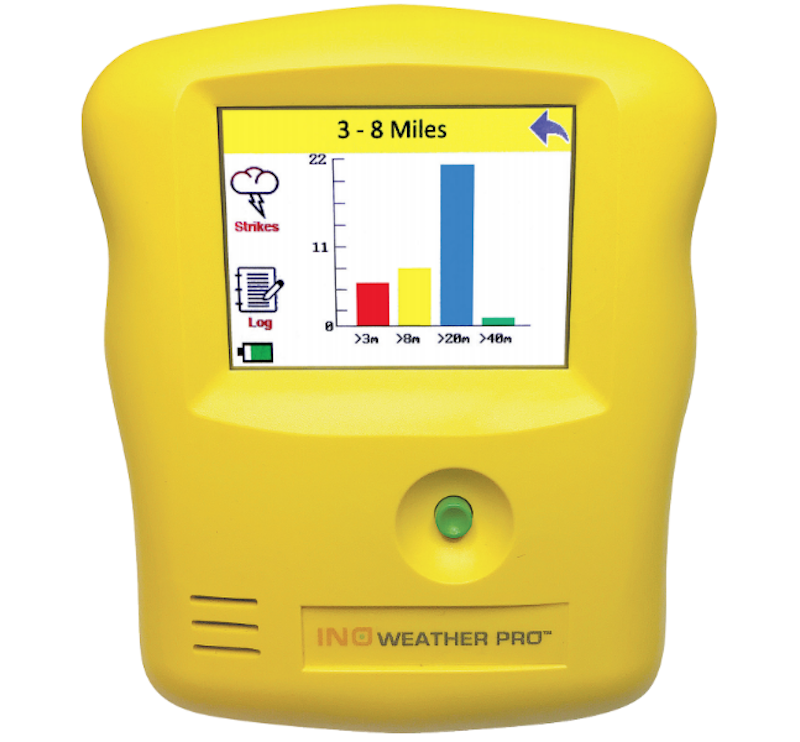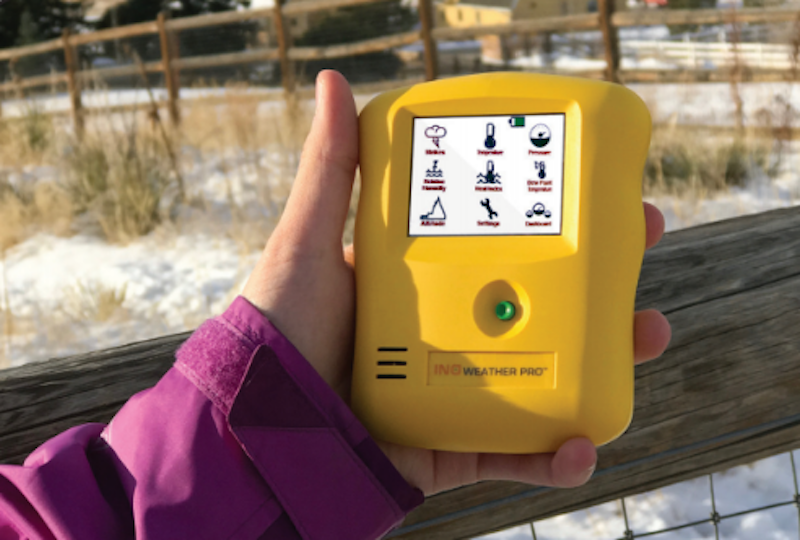When lightning is nearby, high up on a roof or a steel girder is one of the last places you would want to find yourself. With the unpredictability of weather and cell phone and internet service making it difficult to anticipate exactly when and where a storm will hit, a recently released handheld device looks to add one more weapon to the arsenal of outdoor weather intelligence products that can help keep construction crews safe.
The INO Weather Pro is, according to INO Technologies, the first handheld device that combines weather data with lightning detection. Most lightning detection technologies rely on national weather data feeds, which require an internet or cellular connection to update. But cell and internet service may not always be available on a construction site, which is why the INO Weather Pro uses its own sensor to provide real-time local lightning detection and direction. The company claims the INO Weather Pro can detect cloud-to-ground lightning strikes as far away as 40 miles.
When a strike is detected, the device will alert the wearer with both visual and auditory feedback of the strike’s distance. The INO Weather Pro uses updatable software and a customizable touchscreen display that allows users to fill their dashboards with the information that is most pertinent to them. In all, the INO Weather Pro provides seven functions: lightning detection, temperature, atmospheric pressure, humidity, heat index, altitude, and dew point.
The water-resistant device runs on a USB charged Lithium battery and has a suggested retail price of $497.
 Photo courtesy of INO Technologies.
Photo courtesy of INO Technologies.
Related Stories
| Aug 11, 2010
Special Recognition: Kingswood School Bloomfield Hills, Mich.
Kingswood School is perhaps the best example of Eliel Saarinen's work in North America. Designed in 1930 by the Finnish-born architect, the building was inspired by Frank Lloyd Wright's Prairie Style, with wide overhanging hipped roofs, long horizontal bands of windows, decorative leaded glass doors, and asymmetrical massing of elements.
| Aug 11, 2010
Giants 300 Index and Methodology
BD+C's annual Giants 300 list consists of U.S. firms that designed or constructed the largest volume of commercial, institutional, industrial, and multifamily residential buildings in 2008. Each spring, the editors survey the country's largest firms, ranking the top 300 across six categories: architects, architect/engineers, engineers, engineer/architects, contractors, and construction managers.
| Aug 11, 2010
The pride of Pasadena
As a shining symbol of civic pride in Los Angeles County, Pasadena City Hall stood as the stately centerpiece of Pasadena's Civic Center since 1927. To the casual observer, the rectangular edifice, designed by San Francisco Classicists John Bakewell, Jr., and Arthur Brown, Jr., appeared to be aging gracefully.
| Aug 11, 2010
Education's Big Upgrade
Forty-five percent of the country's elementary, middle, and high schools were built between 1950 and 1969 and will soon reach the end of their usefulness, according to the 2005–2008 K-12 School Market for Design & Construction Firms, published by ZweigWhite, a Massachusetts-based market-research firm.
| Aug 11, 2010
Great Solutions: Technology
19. Hybrid Geothermal Technology The team at Stantec saved $800,000 in construction costs by embedding geothermal piping into the structural piles at the WestJet office complex in Calgary, Alb., rather than drilling boreholes adjacent to the building site, which is the standard approach. Regular geothermal installation would have required about 200 boreholes, each about four-inches in diameter ...







